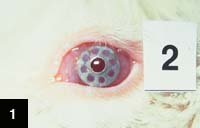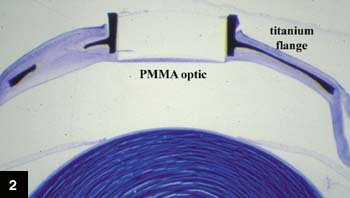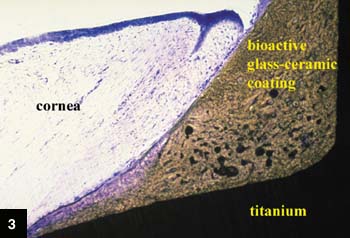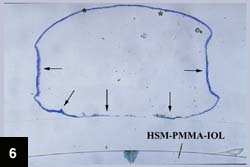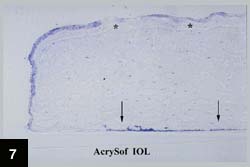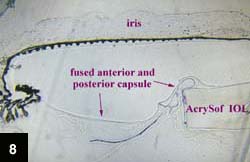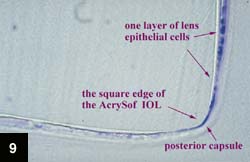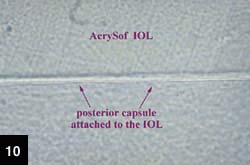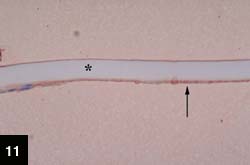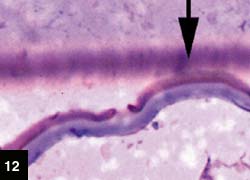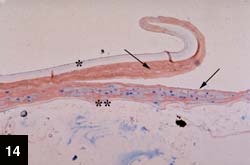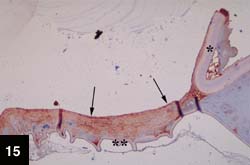‘Sandwich’ theory explains role of IOL design, bioactivity in PCO
Studies show good results with AcrySof IOL because of its square-edge design, material structure and surface adhesion properties.
Click Here to Manage Email Alerts
There are many factors that affect an IOL’s behavior in the eye and the amount of posterior capsular opacification that develops after cataract surgery. Surgical factors include careful operational technique with good hydrodissection, careful cortical cleaning and creation of a good capsulorrhexis smaller than the IOL optic. This permits a better sealing of the capsular bag over the IOL.
|
|
A square edge is clearly a must for an IOL, as seen in many studies. The benefit of the square edge has been shown by Okihiro Nishi, MD, in animal studies and David Apple, MD, in human autopsy eyes.
The mechanism of the sharp edge has since been further evaluated by David Spalton, FRCOphth.
“The mechanism behind PCO prevention might be the pressure barrier effect that the square edge induces against the posterior capsule, inhibiting lens epithelial cell (LEC) growth. By calculating with a mathematical model, the square-edge IOL induces 60% to 70% more pressure against the posterior capsule than a round-edge IOL,” Dr. Spalton wrote.
This current report describes animal experiments, in vitro IOL studies and studies with pseudophakic human autopsy eyes that we performed between 1991 and 2002.
Our studies were concerned more with the response of IOL material to LECs and the capsular bag. There were clear differences among the IOLs we studied. The studies described here clearly show the advantage of soft hydrophobic acrylate as an IOL material.
We developed the “sandwich” theory to explain the notable lack of PCO development seen with certain types of IOLs.
Ten years of study
The first of these studies had nothing to do with IOLs, but was a material study to find a better attachment of keratoprostheses to the cornea than PMMA prostheses. Keratoprostheses made of PMMA have a high tendency to epithelial downgrowth around the prosthesis, causing leakage, infections and loosening of the prostheses.
Assessment of titanium and bioactive glass-ceramic coated titanium as materials for keratoprosthesis was performed in a cooperative study by the department of ophthalmology, University of Oulu, and the department of prosthetics, Institute of Dentistry, University of Turku, both in Finland.
This study was done at a time when most IOLs were made of PMMA. We could see that a PMMA keratoprosthesis did not attach to the corneal stromal tissue.
After our own clinical experience and successful clinical reports with soft hydrophobic acrylate IOLs, we undertook our own studies to discover the possible reasons for less PCO being associated with IOLs made of this material.
|
|
The “sandwich theory” as an explanation for variable PCO formation with different IOLs was presented in 1996. It connects the results from the keratoprosthesis study and the clinical behavior of soft hydrophobic acrylate IOLs.
We first tested the bioactivity of different IOL materials with rabbit corneal tissue cultures in the department of oral and maxillofacial surgery of the Institute of Dentistry, University of Turku. Better adhesion of tissue was associated with soft hydrophobic acrylate IOLs.
Then extracellular matrix protein adsorption to IOLs was studied with a radioactive iodine labeling method performed at the collagen research unit, biocenter and the department of medical biochemistry, University of Oulu.
Finally, the role of fibronectin, vitronectin, laminin and collagen type IV was analyzed in pseudophakic human autopsy eyes. This study was done at the Center for Research on Ocular Therapeutics and Biodevices, Storm Eye Institute, Medical University of South Carolina.
The main results and conclusions of all of these studies are presented here.
Keratoprosthesis attachment
We obtained a bioactive type of bonding of keratoprosthesis material to corneal stromal tissue with bioactive glass-ceramic coated titanium (figure 1). Bioinert titanium also managed well (figure 2), but when histologic findings were considered, bioactive glass-coated prostheses were shown to have better bioactive attachment with less epithelial ingrowth.
PMMA prostheses did not show any attachment at all to the corneal stromal tissue. After only 1 month, they were totally surrounded by epithelial in-growth (figures 3, 4).
|
|
Sandwich theory
We developed the “sandwich” theory to explain the prevention of PCO formation in IOLs with a suitable amount of bioactivity.
A continuous curvilinear capsulorrhexis is performed during cataract surgery. The anterior capsule over the IOL bonds directly, or as a result of the remaining lens epithelial cells, to the IOL’s bioactive surface, preventing further LEC proliferation. Thus, the anterior capsule over the IOL remains clear.
When this bonding is complete, the IOL and the capsular bag are a closed system. Inside the bag, remaining LECs proliferate and migrate behind the IOL. The 90º edge of the IOL optic against the posterior capsule hinders or directs the proliferating LECs to form a monolayer between the IOL and the posterior capsule.
Another bioactive bond is formed when a single LEC has the posterior capsule on one side and the bioactive IOL surface on the other side. A “sandwich” is formed, and the junctions between both the cell and the posterior capsule and the cell and the bioactive IOL surface prevent more cells from migrating behind the IOL (figure 5). The posterior capsule remains clear.
After some time, some of the monolayer cells will die because of aging, poor nutrition or the IOL-induced pressure on the posterior capsule.
Cell culture medium
To determine the tissue response and adhesion capacities of different IOL materials, rabbit corneal tissue cultures were set up on PMMA, heparin surface modified-PMMA (HSM-PMMA), silicone, soft hydrophobic acrylate (AcrySof, Alcon) and hydrogel (Hydroview, Bausch & Lomb) IOLs for 1 week.
The tissue consisted of intact epithelium and half the thickness of the corneal stroma, which was placed against the IOL. The growth of the epithelium was examined by light microscopy to evaluate the attachment of the explant to the IOL surface. When grown on PMMA, HSM-PMMA, silicone and hydrogel, the tissue did not attach to the IOL, or the epithelium grew around the explant, suggesting that the attachment of the stroma to the IOL was either poor or nonexistent (figure 6). By contrast, some of the explants grown on acrylate IOLs attached directly to the IOL surface with no epithelial ingrowth between the stroma and the IOL. The results suggested that acrylate IOLs might have bioactive properties (figure 7).
|
Fibronectin adsorption
To determine what mechanism could be behind this better adhesion of acrylate IOL material to tissue, we went on to study whether there are differences in extracellular matrix protein adsorption in different IOL materials.
Why study this? The biological role of extracellular matrix proteins such as fibronectin, vitronectin and laminin is to act as a glue between different tissues and between cells and other tissues. For example, in the eye the capsular bag is made of collagen type IV, and fibronectin has in its structure functional binding sites to collagen.
So if an IOL adsorbs more fibronectin to its surface, it is better able to attach with this fibronectin to the capsular bag. The fibronectin can originate from lens epithelial cells, but more important, there is free fibronectin in our blood circulation all the time.
After the breakdown of the blood aqueous barrier, this fibronectin, together with other proteins, is free to adsorb the IOL surface. With more fibronectin on the IOL surface, there would be better and faster IOL adhesion to the capsular bag.
In this study, 75 IOLs were incubated with radioactive iodine-labeled soluble fibronectin, laminin or collagen type IV. Twenty-five IOLs were analyzed for each protein; 5 each were made of PMMA, HSM-PMMA, silicone, acrylate and hydrogel. The amount of adsorbed protein was measured with a gamma counter.
Soft hydrophobic acrylate showed the highest binding of fibronectin, the difference being significant relative to all the other materials except PMMA. Hydrogel had the highest overall binding of laminin. Acrylate bound significantly more laminin than PMMA, HSM-PMMA or silicone. Hydrogel also showed significantly more binding of type IV collagen than any of the other IOLs.
Pseudophakic autopsy eye study
After the previous in vitro and animal studies, it was time to see whether the presented hypotheses could be confirmed in human pseudophakic autopsy eyes. Tight adhesion of anterior and posterior capsule to soft hydrophobic acrylate IOLs was seen in plastic-embedded sections of a human pseudophakic autopsy eye. A structure as proposed in the sandwich theory was seen, with a monolayer of lens epithelial cells (figures 8, 9, 10).
|
Immunohistochemical study
In the immunohistochemical study, 38 autopsy eyes containing PMMA, silicone, hydrophobic acrylate or hydrogel IOLs were assessed. Histologic sections were prepared from each eye, and immunohistochemical analyses were performed on 152 specimens for fibronectin, vitronectin, laminin and collagen type IV.
A sandwich-like structure (consisting of anterior or posterior capsule, fibronectin, one cell layer, fibronectin, IOL surface) was seen significantly more often with soft acrylate IOLs than with PMMA, silicone or hydrogel IOLs. The thicker fibrocellular tissue on the inner surface of the anterior or posterior capsule that was in contact with silicone IOLs was lined with collagen type IV. Vitronectin and laminin were not found at the fibrocellular tissue-IOL interface of any specimen. When explanted IOLs from 32 human autopsy eyes were examined, a significant difference in protein adsorption was seen.
Soft hydrophobic acrylate IOLs had significantly more fibronectin adhering to their surfaces than PMMA and silicone IOLs, as well as more vitronectin. Silicone IOLs had more collagen type IV adhesion than the other IOLs. Collective protein adhesion differed significantly between soft acrylate and PMMA or silicone, but not between PMMA and silicone (figures 11 to 16).
Extracellular matrix protein adsorption
After the pseudophakic autopsy eye study, we returned to study extracellular matrix protein adsorption to different IOL materials using the radioactive iodine-labeling method. This was done because more acrylate IOLs, both hydrophobic and hydrophilic, were coming to the market and we wanted to see if there were differences between them in fibronectin adsorption.
We analyzed 150 IOLs of 10 different types. The materials studied were PMMA, fluorine-surface-modified PMMA, silicone, hydrogel, soft hydrophobic acrylate and soft hydrophilic acrylate.
We demonstrated that both hydrophobic acrylate IOLs tested (the Alcon AcrySof and the Allergan Sensar) had similar capacities in in vitro fibronectin binding. Both soft hydrophobic acrylate IOLs had significantly higher binding of fibronectin than the soft hydrophilic IOLs tested (the IOLTECH Stabibag, the Bausch & Lomb BL 27) or hydrogel IOLs (the Hydroview) (P < .05 to .001).
| ||||
Conclusion
Where all our studies are concerned, we saw the most fibronectin adhesion to the soft hydrophobic acrylate IOL material when compared to silicone, PMMA, HSM-PMMA, hydrogel and soft hydrophilic acrylate.
Our findings also show that of all the extracellular proteins we studied, fibronectin is the major extracellular protein binding between the hydrophobic soft acrylate IOL and the capsular bag. Because of the accepted biological role of fibronectin, it is likely to act as a true bioactive bond between the IOL and the LECs or capsular bag, which suggests a reason for the lower PCO and Nd:YAG rates reported with AcrySof lenses.
Finally, the good results obtained with the AcrySof IOL seem to be related to its optimal design with a square edge, its optimal material structure with a contact angle suitable for cell attachment and good adhesion properties for maximal fibronectin adhesion to its surface.
For Your Information:
- Reijo J. Linnola, MD, PhD, can be reached at Saratie 16 D, 65280 Vaasa, Finland; (358) 40-530- 6000; fax: (358) 6321-6689; e-mail: reijo.linnola@pp.qnet.fi.
- Alcon Pharmaceuticals, makers of the AcrySof IOL, can be reached at 6201 South Freeway, Fort Worth, TX 76134; (817) 293-0450; fax: (817) 568-6142.
References:
- Linnola RJ, Happonen RP, et al. Titanium and bioactive glass-ceramic coated titanium as materials for keratoprosthesis. Exp Eye Res. 1996;63:471-478.
- Linnola RJ. The sandwich theory: a bioactivity based explanation for posterior capsule opacification after cataract surgery. J Cataract Refract Surg. 1997;23:1539-1542.
- Linnola RJ, Holst A. Evaluation of a 3-piece silicone intraocular lens with poly(methyl metacrylate) haptics. J Cataract Refract Surg. 1998;24:1509-1514.
- Linnola RJ, Salonen JI, Happonen R-P. Intraocular lens bioactivity tested using rabbit corneal tissue cultures. J Cataract Refract Surg. 1999;25:1480-1485.
- Linnola RJ, Sund M, et al. Adhesion of soluble fibronectin, laminin and collagen type IV to intraocular lens materials. J Cataract Refract Surg. 1999;25:1486-1491.
- Linnola RJ, Werner L, et al. Adhesion of fibronectin, vitronectin, laminin and collagen type IV to intraocular lens materials in pseudophakic human autopsy eyes; Part 1: Histological sections. J Cataract Refract Surg. 2000;26:1792-1806.
- Linnola RJ, Werner L, et al. Adhesion of fibronectin, vitronectin, laminin and collagen type IV to intraocular lens materials in pseudophakic human autopsy eyes; Part 2: Explanted IOLs. J Cataract Refract Surg. 2000;26:1807-1818.
- Linnola RJ. The sandwich theory: a bioactivity based explanation for posterior capsule opacification after cataract surgery with intraocular lens implantation. Dissertation; University of Oulu. Acta Univ Oul D. 2001:632. Thesis is available on the Web at: http://herkules.oulu.fi/isbn9514259793/.

